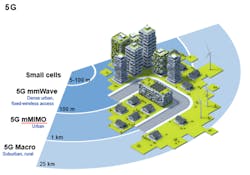5G Densification: Making 5G a Working Reality
Members can download this article in PDF format.
As the rollout for 5G cellular continues, network operators are modifying the existing infrastructure. They’re adding what’s needed to support the higher rates, greater device density, and lower latency we’ll need to run advanced 5G use cases, now and in the future.
Operators have done this kind of work before, moving cellular from 2G to 3G and 4G, but this time it’s different. 5G is more than just an overlay on the previous generation—it's a seismic shift that brings fundamental change at every level. Preparing for 5G operation means having to deal with new technologies and new techniques, from recently opened bands of unfamiliar spectrum and complex active antenna architectures to virtualization and machine-learning algorithms.
At the same time, the goal of infrastructure investment has taken a turn. The traditional focus, in place for roughly 30 years, has been on coverage and trying to find the lowest cost per square kilometer serviced. The focus for 5G, on the other hand, is on capacity, and trying to find the lowest cost per gigabit delivered.
As the network is becoming denser, with more pieces of equipment used to provide 5G capacity within a given area, it’s also becoming more diverse—more types of equipment are used to deliver 5G service. What was once a network dominated by traditional macro cells is becoming an intricate mix of technologies used to deliver capacity where it’s needed most.
The complexities of deploying this kind of heterogeneous network are offset by the fact that the cellular service becomes more flexible, making it easier to meet changes in demand and support new use cases while managing costs. To understand the economics of these investment decisions, it’s useful to review what makes 5G different and, as a result, more challenging to work with.
Three Ways 5G is Different
Three things that set 5G apart from previous generations are 1) where in the wireless spectrum it operates; 2) the antenna structure used to transmit and receive signals; and 3) the transition to a more software-based approach to managing and optimizing operation.
- New spectrum: As shown in Figure 1, 5G extends the existing cellular spectrum to include the area between 2.7 and 6 GHz and adds a completely new part of the spectrum above 25 GHz. This new portion of the spectrum, known as millimeter wave (mmWave), was previously reserved for other services, such as medical imaging, microwave remote sensing, amateur radio, terahertz computing, and radio astronomy. It will enable ultra-high bandwidth and ultra-low latency use cases but presents a steep learning curve for engineers used to working below 6 GHz.
- New antenna configurations: 5G uses active antennas, which are more highly integrated and more complex than the passive antennas traditionally associated with cellular. Active antennas require a sophisticated mix of hardware and software and leverage massive MIMO (mMIMO), a technique that involves dozens (if not hundreds) of antennas working together to expand capacity within the same bandwidth. Working with so many antennas is a complex, compute-intensive task that requires careful optimization to ensure reliable, interference-free operation.
- More code: 5G makes extensive use of virtualization, with more being done in the cloud, and often uses machine-learning (ML) algorithms for optimized network management, orchestration in the core, traffic monitoring, and load balancing. A typical 5G base station has millions of lines of code, using software to add new features like support for more devices, increased capacity, and expanded coverage to accommodate more traffic. Heavy reliance on software changes how the network is deployed and operated and changes the security models.
Putting 5G to Work in Layers
Preparing the infrastructure for 5G operation, through what’s known as 5G densification, involves adding different layers of coverage, each providing the throughput improvements needed for a given area or use case. As shown in Figure 2, these layers consist of traditional 5G macrocells, 5G mMIMO cells, 5G mmWave cells, and small cells.
- Traditional 5G macrocells: Serving a wide area of about 25 km, traditional 5G macrocells mainly provide capacity in suburban and rural environments. Like their 4G counterparts, traditional 5G macrocells are big, high-powered base stations that live on towers, monopoles, and rooftops, and are sometimes made to look like giant trees. They typically use a passive antenna system and a simple multiple-input, multiple-output (MIMO) configuration for transmission and reception that employs either four antennas (4T4R) or eight antennas (8T8R) driven at 40 W.
- 5G mMIMO cells: Serving a smaller area of about 1 km, 5G mMIMO cells are used to provide capacity in urban environments that have a higher device density than suburban and rural areas. The traditional macrocell’s passive antenna and radio unit are replaced with an active antenna system. The active antenna system combines mMIMO configurations with other 5G features, such as beamforming, to increase throughput while reducing interference. Typical configurations use 32 antennas (32T32R) driven at 10 W or 64 antennas (64T64R) driven at 5 W.
- 5G mmWave cells: Serving an area of about 100 m, 5G mmWave cells use the new spectrum above 25 GHz to provide capacity in urban environments with very high device density as well as support fixed wireless access (FWA) in buildings. Working in the mmWave spectrum means exceptionally high bandwidth, made possible by using hundreds of antennas in a mMIMO configuration (e.g., 256R256T) driven at 200 mW. However, because mmWave signals have a lower wavelength, they don’t travel as far. To balance the tradeoff between bandwidth and power consumption, 5G mmWave cells have limited range.
- 5G small cells: Serving an area of between 5 and 100 m, 5G small cells are backpack-sized, low-power base stations that provide targeted capacity in network “hotspots.” Small cells are compact and lightweight, so they can be mounted just about anywhere. They prevent 5G signals from being dropped in crowded areas, such as city centers or sports venues. A 5G small cell is, in many ways, a miniature, low-power version of a traditional 5G macrocell. It typically uses a passive antenna with a smaller MIMO setup of just four antennas (4T4R), but driven by a much lower power of just 1 W.
Finding the Right Mix
The layered approach takes advantage of the fact that 5G is a standard that meets many different requirements. It also lets operators tailor network operation to meet specific needs while keeping costs in check.
A single operator might, for example, use 2T2R or 8T8R macrocells to service rural and suburban areas, while using 32T32R or 64T64R mMIMO cells to service semi-dense urban areas and dense urban areas with tall buildings. The higher cost of mmWave can be saved for the areas with the highest densities, such as a crowded business district, an international shipping port, or an entertainment venue that hosts major sporting and cultural events.
A Work in Progress
Completing the process of 5G densification will take time. The 5G networks already in place today mostly leverage legacy 4G networks, in what’s called a non-standalone (NSA) network setup. The 5G capability is essentially anchored to 4G, so that users can back off an LTE connection when a 5G connection is unavailable.
Before 5G becomes widely available, mMIMO can be used to increase LTE speeds and improve latency. However, the real benefit of mMIMO, and its positive effect on network density, will kick in once the infrastructure transitions to the standalone (SA) setup, which is a pure 5G network for higher-frequency operation.
The transition to SA networks will help drive uptake of mMIMO and accelerate 5G densification. ABI Research, in its February 2021 report on network infrastructures, calculated that the installed base mMIMO market is expected to grow at a compound annual growth rate (CAGR) of 63.8% between 2020 and 2026 to reach $58.2 billion by 2026. The Asia-Pacific market will be particularly strong, with MNOs expected to deploy 28.3 million units—more than 78% of the total mMIMO market—by 2026.
5G and Wi-Fi 6/6E
While cellular networks have been evolving toward 5G, Wi-Fi networks also have been evolving to the next generation. Known as Wi-Fi 6/6E, the latest versions of Wi-Fi bring the high-throughput and low-latency benefits of 5G to the indoor environment and are much easier to deploy than 5G. Chipsets for Wi-Fi 6, which runs in the licensed 2.5- and 5-GHz spectrum, and Wi-Fi 6E, which runs in the unlicensed 6-GHz spectrum, are already available.
Cellular and Wi-Fi are complementary technologies. Today’s smartphones already combine the two, making it possible to switch from cellular to Wi-Fi when the cell signal is weak or to save on data usage. This trend is expected to continue, with Wi-Fi 6/6E and 5G small cells working in tandem to support more devices accessing more data, all at once.
5G can even boost the deployment of Wi-Fi 6/6E by making it easier to connect Wi-Fi signals to the core network. In FWA applications, for example, 5G mmWave cells can be used as the backhaul service, replacing the expensive fiber-optic cabling currently used to link many Wi-Fi gateways to the core network.
5G isn’t a one-size-fits-all proposition. From power amplifiers, high-power transistors, beamforming ICs, and highly integrated receiver and driver modules to power-efficient Arm processors and customizable, DSP-driven baseband devices, the right components make the 5G infrastructure more efficient, more effective, and more reliable.
About the Author
Franck Nicholls
Head of Commercial Marketing, RF Power, NXP Semiconductors
Franck Nicholls is the head of Commercial Marketing within the Radio Power Business Line at NXP. He’s responsible for promoting NXP’s RF Power solutions. Prior to this position, Franck held several marketing and business development responsibilities for NXP and previously Freescale in the U.S. and Europe. Franck received his M.Sc. degree from Telecom Paris in France.


